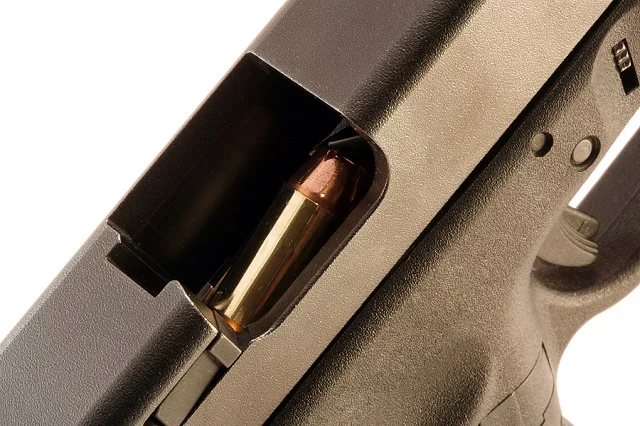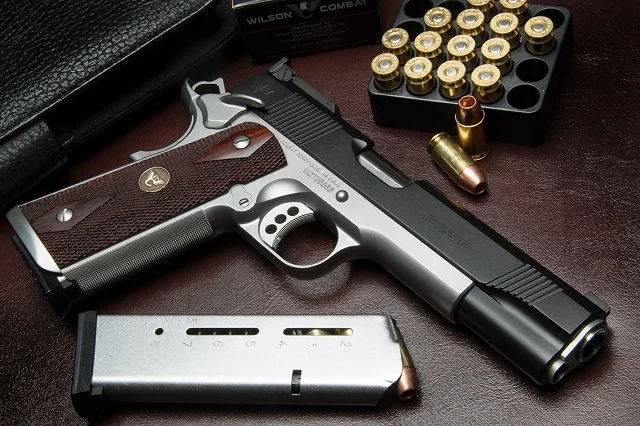
The "Safest Handgun For Concealed Carry"? A Gun Is Only Safe If You Are
What's the safest handgun for concealed carry? Generally, it's whatever you can carry safely, responsibly and effectively. A gun carried safely is safe.
That sounds a little ambiguous, doesn't it? Well, it is, because ultimately you're either safe with a gun or you're not.
If you're going to own and carry, it is absolutely and completely upon you to know and demonstrate command of the basic tenets of gun safety. If we, the gun-owning/Second Amendment community or whatever you want to call it, are going to have this narrative of "responsible gun owners" then by God, we better act the part.
Remember, you carry a gun in case you need to use it to put a stop to a threat. You don't carry a gun to be a threat to yourself and others. The gun and its safety features...are less important than YOU conducting yourself in a safe manner.
We're going to go over some basics of safe handling and carrying of firearms, and how that relates to handgun design. We'll also discuss a few solid candidates for the "safest" possible carry gun.
What Is The Safest Gun To Carry? The Gun You Are Safest With

The relative safety or unsafety of a gun, whether for concealed carry or otherwise, has nothing to do with the gun and everything to do with the person carrying it.
Think of it...kind of like this.
A modern commuter car has disc brakes, an anti-lock system, independent suspension, power steering and traction control. That's a lot of safeguards for safe operation of a vehicle.
Older cars...don't, even the high-end ones. For instance, a 1958 C1 Corvette (the one with the twin headlights *drooling intensifies*) has a solid rear axle (both rear wheels powered, all the time) drum brakes, no power steering and certainly no traction control.
Does this mean that a C1 'Vette is a death trap? If you drive unsafely, it's a lot more dangerous. However, if you don't drive like an idiot, you're perfectly safe.
It's the same with guns. Safety is relative; if you carry safely, and handle and operate a gun safely, bad things tend not to happen.
In fact, let's talk about classic examples of mismanaged firearms and why - just like with car crashes - it's almost entirely down to user error.
Negligent Discharges Are Entirely Preventable

Almost all accidental or negligent discharges (some say they're the same thing, but let's not get bogged down in semantics) take several forms, in that almost the same thing occurs.
For instance, a person is handling a loaded gun and it goes off. Alternatively, a person is reaching into a bag or backpack for a loaded gun...and it goes off. A person is taking their modern striker-fired pistol down for cleaning and it goes off.
A person has a pistol in their pocket...and it somehow goes off.
What is the common denominator here? Is it Glocks or other striker-fired mechanisms?
Nope.
It's user error. Every. Single. Time.
The same is true for most car crashes. The most common error drivers make is driving too fast for conditions, which is why excessive speed kills almost as many people per year in traffic accidents as drunk driving does.
Don't believe it? Ask the NHTSA; they have data (26 percent of traffic fatalities) to prove it.
Just like with gun designs, it isn't cars that get people killed except for very rare circumstances. It's usually the driver.
For instance, first-generation Porsche 911 Turbo sports cars were often called "widow makers." The cars were known for violent oversteer (rear wheel drift) which resulted in a number of crashes and a few fatalities, earning the 911 Turbo a bad reputation in the process.
What few people realized at the time was that the first-gen 911 Turbo had only one turbocharger. The turbo spools until the proper pressure is reached and then delivers more air to the engine, drastically boosting RPM and engine output and typically when you aren't paying attention.
Now, that's no big deal to a racing driver; single turbo systems aren't mysterious to them and they know how to manage it. Some stupid yuppie who bought a 911 Turbo because it was expensive? Branston "Skip" Williams III with his fake tan and bad haircut is gonna have a bad day!
The cars got a bad reputation because people who didn't know how to drive them got themselves in trouble due to ignorance and stupidity. Similarly, some guns get a bad rap because of irresponsible use by the people who buy them.
In the case of modern polymer-frame striker-fired guns, what happens is the trigger is pulled unintentionally or carelessly by the user, the trigger is pulled by something else due to negligence on the part of the user, or the user didn't check the chamber.
If you don't touch the trigger until you mean to shoot, and safely holster ANY pistol and carry it accordingly, these things don't and can't happen.
There are some dangers due to older designs, such as single-action revolvers which lack a transfer bar...but that was addressed long ago by safe practices of the day. So really, it comes down to the safety of the user, not the gun.
On Paper, The Safest Firearm For Concealed Carry Is Either A 1911 Or A Beretta 92

However, since we're on the topic, is there a "safest" gun in terms of mechanical safeguards that would potentially qualify as the "safest" handgun to concealed carry? This is going to make some people mad, but 1911 and Beretta 92 pistols (or derivatives) come pretty darn close.
Here's why:
When we're talking about the mechanical, on-paper relative safety of a gun, what one is looking for is the greatest number of positive safety features (meaning things you have to deliberately do to make the gun fire) between the gun at rest and the trigger being pulled and a cartridge discharged.
In engineering, that's called a "redundancy." And in safety systems, it's a good thing.
A modern 1911 with a firing pin block system (Series 80) has three safety features enacted when the pistol is carried in Condition One/cocked and locked. The thumb safety is engaged, the grip safety is not depressed, and the firing pin block is...well...blocking the firing pin.
What that means is that not only does one safety feature have to be deactivated, three of them do.
In other words, the trigger of a 1911 pistol cannot be pulled unless the person carrying it darn well meant to. Sorry polymer fanbois; John Moses Browning wins again. The gun has to be grasped, the safety disengaged and the trigger pulled. Compared to other guns as designs, that's as good as it gets.
Similarly, the Beretta 92/PX4/8000/9000 family (as well as S&W 39s/59s) has a certain level of redundancies as well. A firing pin block keeps the firing pin blocked until the trigger is pulled, and the user can opt to carry with the safety off and the pistol decocked, or decocked and safety on.

With the safety on, the trigger is deactivated. When the safety is deactivated, there's a longer, harder trigger pull due to the double-action trigger system. Again, redundancies.
Some other honorable mentions include H&K's double/single pistols (USP, P2000, HK45 etc.) and any other double/single action pistol with a decocking safety.
As mentioned, when one considers "safest" in terms of the greatest number of safeguards in the way of the firing pin/striker hitting the primer...the 1911 and DA/SA pistols with decocking safeties (not just decockers or manual safeties, sorry Sig and CZ fans) have the most.
Does that mean these are the only safe guns to carry? No. They're not. Plenty of negligent or accidental discharges have occurred with those guns as well. Again, it's HOW you carry and handle a gun, not WHAT gun you handle and carry.
How To Concealed Carry Safely, With ANY Handgun

In truth, how to concealed carry safely with any gun is not complicated. It's just that some people are too lazy to be bothered and those people are the ones that get themselves in trouble.
Start by not excessively handling any loaded gun. If you aren't preparing to shoot, or in the act of unloading it or loading prior to storage, it must be safely stored in either a holster or a safe. The more you touch a loaded gun, the more chances you take.
You have to select a concealed carry holster that is made to securely retain the make and model pistol you carry. It should completely cover the trigger guard, and should be capable of retaining the gun without need of an active retention device.
Active retention should be a layer of security, not the source of it.
Ensure the holster is free of any obstruction prior to holstering your pistol. Look the gun into the holster. Every...single...time.
Single-action pistols are meant to be carried with the safety engaged. This includes 1911 pistols and micro variants, Browning Hi Power pistols and clones, and if we're being honest, CZ 75 pistols (and clones) with manual safeties.
Your holster should be secured to your person by means of a stout belt or other secure mounting system such as straps.
Remember the four rules of gun safety. Never touch the trigger unless you're going to shoot.
Never assume the chamber is clear before dry-firing. Verify that it is. This is of crucial importance with striker-fired pistols that must be dry-fired (in other words, decocked) before take-down.
Never, ever, under any circumstances, carry your gun in a pocket or in a bag without a holster.
To sum up, the truth is that any gun can be carried safely and plenty of people have and do safely carry, handle and operate any and every make and model of firearm that have been said to be unsafe by the ignorant.
And you can too. All you need to do is know your gun, understand how it works and respect it's potential failure points, and then conduct yourself accordingly. A little bit of brains and some consistency go a very long way.








